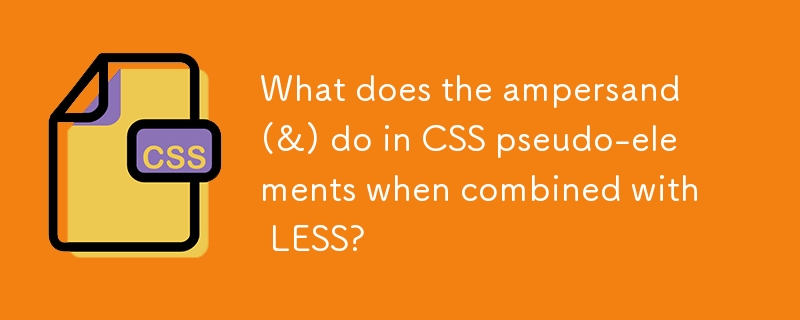Home >Web Front-end >CSS Tutorial >What does the ampersand (&) do in CSS pseudo-elements when combined with LESS?
What does the ampersand (&) do in CSS pseudo-elements when combined with LESS?
- Mary-Kate OlsenOriginal
- 2024-10-27 03:59:30914browse

Understanding the Ampersand (&) in CSS Pseudo-Elements
In CSS, pseudo-elements can be used to add styling to elements without modifying the content or structure of the HTML. When used in conjunction with pseudo-elements, the ampersand (&) character serves a specific purpose.
Consider the following CSS snippet, often seen in Twitter Bootstrap:
.clearfix {
*zoom: 1;
&:before,
&:after {
display: table;
content: "";
}
&:after {
clear: both;
}
}
In this code, the ampersand (&) is used before the pseudo-elements :before and :after. This indicates that the styles applied to the pseudo-elements are only applicable when applied to the parent element with the class ".clearfix".
It's important to note that this syntax is not native to CSS. It originates from LESS, a CSS preprocessor. In LESS, the ampersand (&) allows for the nesting of selector modifiers. For instance:
.clearfix {
&:before {
content: '';
}
}
This code will compile to:
.clearfix:before {
content: '';
}
The presence of the ampersand (&) ensures that the nested selector compiles to ".clearfix:before". Without it, the resulting code would be ".clearfix :before".
In summary, when used in conjunction with pseudo-elements in LESS, the ampersand (&) character allows for the nesting of selector modifiers, thus providing a convenient way to apply styles specifically to the descendants of a given element.
The above is the detailed content of What does the ampersand (&) do in CSS pseudo-elements when combined with LESS?. For more information, please follow other related articles on the PHP Chinese website!

